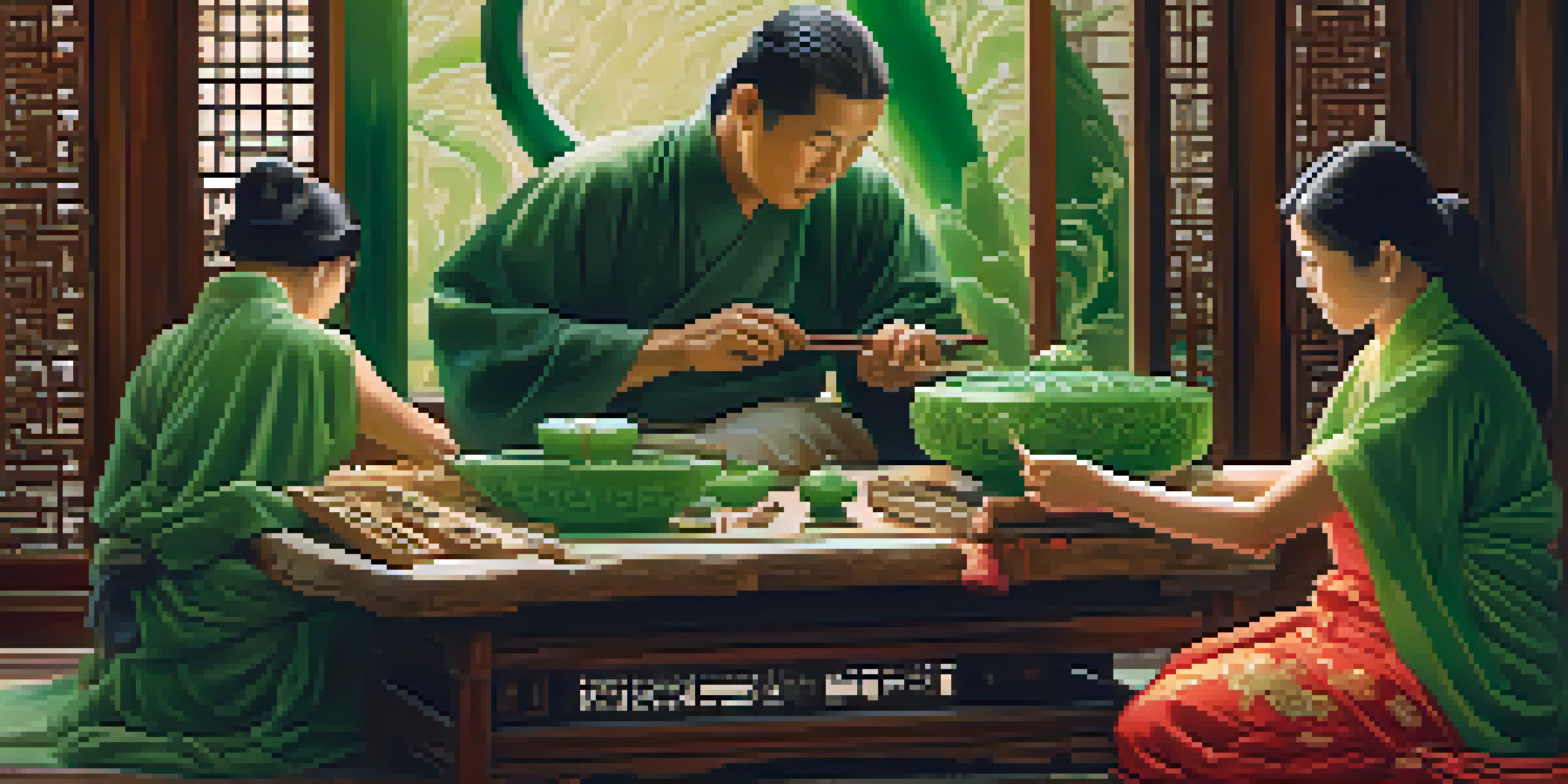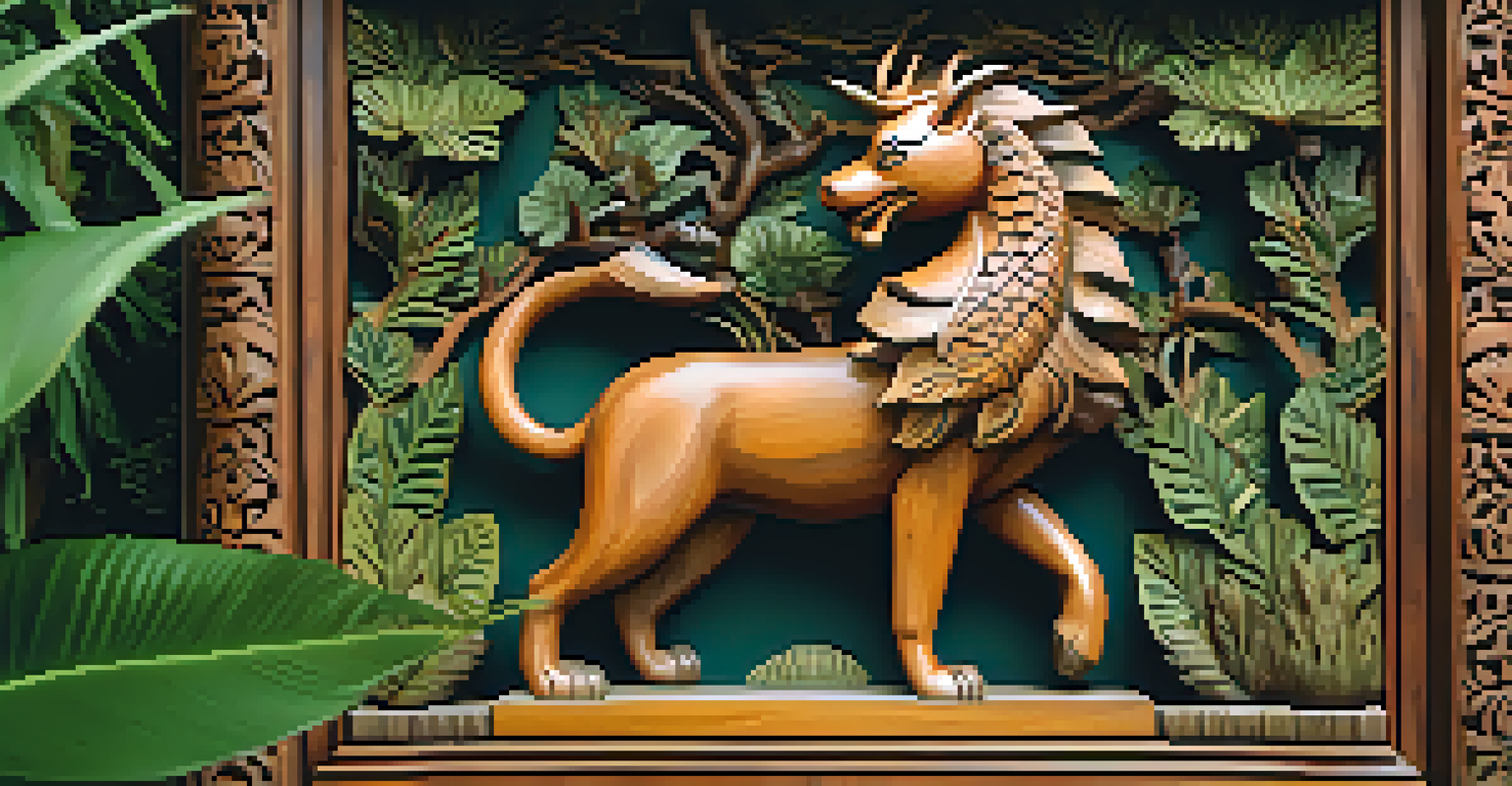Carving in Asia: Techniques and Styles Across Time

The Historical Roots of Asian Carving Techniques
Carving in Asia has deep historical roots, tracing back thousands of years. Ancient civilizations used carving not only for artistic expression but also to convey cultural narratives. From the intricate designs of ancient Chinese jade carvings to the stone sculptures of India, these techniques have evolved while maintaining their cultural significance.
Art is the most beautiful of all lies.
Many traditional practices were passed down through generations, often taught within families or guilds. For instance, in Japan, the art of woodblock printing and carving was a closely guarded skill, reflecting both craftsmanship and cultural heritage. These historical roots provide a foundation for understanding the diverse styles that emerged across the continent.
As these techniques developed, they often absorbed influences from trade, migration, and the spread of religions. This blending of styles is evident in the carvings found in Buddhist temples across Asia, where local craftsmanship meets the spiritual symbolism of Buddhism. Thus, the historical context shapes the carving practices we see today.
Diverse Materials Used in Asian Carving
One of the fascinating aspects of Asian carving is the variety of materials used, each lending its own character to the final piece. Wood, stone, ivory, and jade are some of the prominent materials that artisans have sculpted for centuries. For example, the rich grains of mahogany or cherry wood are favored for their beauty and durability in Southeast Asian crafts.

In contrast, the intricate detailing found in stone carvings, such as those seen in Angkor Wat, showcases the skill and patience of the craftsmen. These carvings often depict religious scenes, animals, and floral patterns, demonstrating a deep connection to the local culture and beliefs. Jade, revered for its beauty and cultural significance, is often intricately carved into talismans and jewelry in China.
Cultural Heritage Shapes Carving
Asian carving techniques have evolved over thousands of years, reflecting deep cultural narratives and historical influences.
These materials not only influence the aesthetic quality of the artwork but also impact the techniques used. Different materials require specific tools and methods; for instance, jade carving demands precision and specialized tools, while wood can be shaped more freely. This diversity enriches the carving landscape across Asia.
Regional Styles: A Closer Look at East Asia
East Asia is home to some of the most recognized carving styles, particularly in China and Japan. Chinese carving is renowned for its intricate details and symbolic meanings, often seen in furniture, ornaments, and religious artifacts. The use of motifs like dragons and phoenixes reflects cultural values and beliefs, making each piece a storytelling medium.
Every artist dips his brush in his own soul, and paints his own nature into his pictures.
Japanese carving, on the other hand, emphasizes simplicity and elegance, particularly evident in the art of netsuke—small carved toggles used to secure items to a kimono. The craftsmanship showcases a deep respect for nature, with many designs inspired by flora and fauna. This focus on minimalism aligns with the broader principles of Japanese aesthetics.
Both styles, while distinct, share a profound admiration for craftsmanship and cultural significance. The regional characteristics of these carvings not only enhance their beauty but also foster a deeper appreciation for the stories they tell and the traditions they preserve.
Exploring Southeast Asian Carving Styles
Southeast Asia boasts a rich tapestry of carving styles, influenced by indigenous cultures and external factors like trade and colonization. In countries like Indonesia and Thailand, intricate wooden carvings are prevalent, often depicting mythological figures and nature. These carvings serve both decorative and practical purposes, enhancing everyday objects with artistic flair.
The Balinese wood carving tradition, for example, is famous for its detailed and expressive styles, often capturing scenes from Hindu epics. Artisans in this region have developed techniques that allow them to work with the natural grain of the wood, creating pieces that are as functional as they are beautiful. Such practices highlight the connection between art and daily life in Southeast Asian societies.
Diverse Materials Enhance Artistry
Artisans use various materials like wood, stone, and jade, each contributing unique characteristics and requiring specific techniques.
Moreover, the influence of Buddhism and animism can be seen in many carvings, as they often convey spiritual messages or serve as offerings. This blend of the sacred and the everyday not only enriches the cultural landscape but also showcases the versatility and depth of Southeast Asian carving traditions.
The Influence of Religious Beliefs on Carving
Religious beliefs have played a significant role in shaping carving techniques and styles throughout Asia. In many cultures, carvings are created as offerings or to depict religious narratives, making them an essential part of spiritual practice. For instance, Hindu and Buddhist temples often feature elaborate carvings that tell stories from sacred texts, inviting reflection and reverence.
In India, the intricate stone carvings of temples showcase deities and mythological scenes, serving as a visual representation of faith. These carvings are not just decorative; they are integral to the worship experience, guiding the devotee's understanding of the divine. Similarly, in Japan, Shinto shrines often contain beautifully carved wooden structures that embody the connection to nature and spirituality.
This interplay between carving and religion illustrates how deeply intertwined art and belief systems can be. As artisans express their spirituality through their work, they create lasting legacies that resonate with both contemporary and future generations.
Modern Innovations in Asian Carving Techniques
As we move into the modern era, traditional carving techniques in Asia are experiencing a renaissance. Artisans are blending age-old practices with contemporary design, creating pieces that appeal to a global audience while retaining cultural significance. This innovation is evident in everything from home decor to fashion accessories, where traditional motifs are reimagined for modern aesthetics.
Technology also plays a role in this evolution, with tools like CNC machines allowing for precision and new design possibilities. However, many artisans continue to prioritize hand-carving methods, valuing the personal touch and craftsmanship that defines their work. This balance between tradition and modernity enriches the carving landscape across Asia.
Modern Innovations Revive Traditions
Contemporary artisans blend traditional carving methods with modern design, ensuring the craft remains relevant in today's world.
Moreover, the rise of digital platforms for showcasing and selling art has opened doors for artisans, allowing them to reach wider audiences and share their stories. This connection fosters a greater appreciation for traditional crafts, ensuring that these techniques continue to thrive in a rapidly changing world.
Preserving Traditional Carving Arts in Asia
As globalization continues to influence art forms, the preservation of traditional carving techniques becomes increasingly important. Many artisans are working to keep their cultural heritage alive by teaching younger generations the skills and stories behind their art. Workshops and community programs are essential in passing down these traditions, ensuring they are not lost to time.
Additionally, the establishment of organizations and cultural festivals dedicated to traditional crafts helps raise awareness and appreciation for carving arts. These events provide a platform for artisans to showcase their work, share their stories, and connect with potential buyers. By fostering a sense of community, these initiatives contribute to the sustainability of traditional carving practices.

Ultimately, preserving these arts is not just about maintaining techniques; it's about honoring the cultural narratives and identities they represent. As we celebrate the rich tapestry of carving in Asia, we also recognize the importance of safeguarding these traditions for future generations.